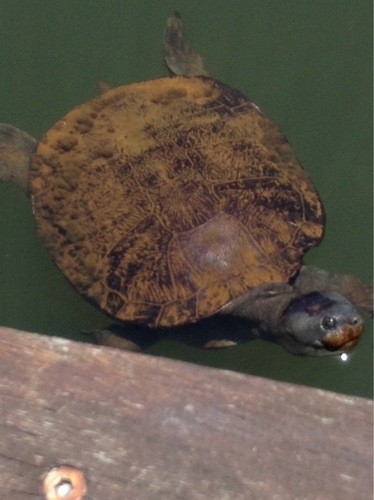Saw-shelled turtle
A species of Australian saw-shelled turtles, Also known as Common sawshell turtle, Eastern saw-shelled turtle Scientific name : Myuchelys latisternum Genus : Australian saw-shelled turtles
Saw-shelled turtle, A species of Australian saw-shelled turtles
Also known as:
Common sawshell turtle, Eastern saw-shelled turtle
Scientific name: Myuchelys latisternum
Genus: Australian saw-shelled turtles
Content
Description General Info
 Photo By questagame , used under CC-BY-NC-ND 4.0 /Cropped and compressed from original
Photo By questagame , used under CC-BY-NC-ND 4.0 /Cropped and compressed from original Description
The saw-shelled turtle, Myuchelys latisternum, is a species of turtle in the Chelidae family endemic to Australia, ranging along rivers and streams and connected swamps and lagoons from coastal Cape York Peninsula to northern New South Wales, with populations also noted as far south as Newcastle - (Williams River Catchment site of the former Tilligra Dam). They are thought to have been introduced to Lake Eacham in the Atherton Tablelands. Other common English names are: serrated.
General Info
Lifespan
20-30 years
Diet
Saw-shelled turtle, primarily an herbivore, tends to favor a diet of aquatic plants, specifically algae. Additionally, they supplement their diet with small invertebrates and decaying organic matter when available.
Appearance
Saw-shelled turtle is a medium-sized freshwater turtle, renowned for its wide, flattened carapace (shell). It boasts an earthy, dark-brown coloration, often accented by subtle, irregular yellow streaks. While smooth in younger individuals, its skin roughens considerably with age. Plus, it possesses a puffy neck, often folded under the shell. Its gender is indistinguishable at a glance, as both males and females exhibit similar appearances.
Behavior
Saw-shelled turtle is primarily nocturnal, displaying crepuscular behavior during warmer months. It's a solitary species, known for its unique shell-rocking self-righting mechanism when flipped upside down. This species is non-territorial, utilizing camouflage in its aquatic habitat for protection. Their diet consists mainly of animal matter, including crustaceans and mollusks.